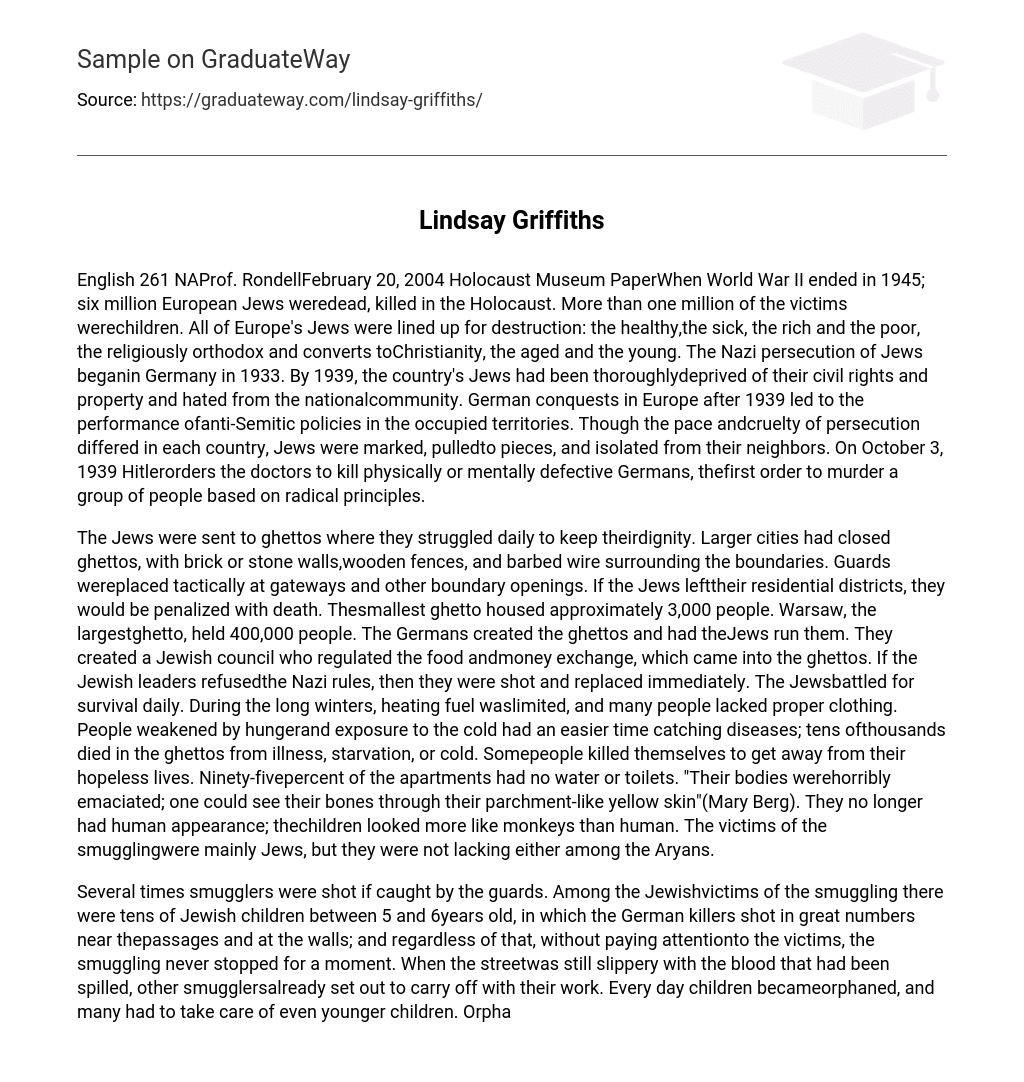When World War II ended in 1945; six million European Jews weredead, killed in the Holocaust. More than one million of the victims werechildren. All of Europe’s Jews were lined up for destruction: the healthy,the sick, the rich and the poor, the religiously orthodox and converts toChristianity, the aged and the young.
The Nazi persecution of Jews beganin Germany in 1933. By 1939, the country’s Jews had been thoroughlydeprived of their civil rights and property and hated from the nationalcommunity. German conquests in Europe after 1939 led to the performance ofanti-Semitic policies in the occupied territories. Though the pace andcruelty of persecution differed in each country, Jews were marked, pulledto pieces, and isolated from their neighbors. On October 3, 1939 Hitlerorders the doctors to kill physically or mentally defective Germans, thefirst order to murder a group of people based on radical principles.
The Jews were sent to ghettos where they struggled daily to keep theirdignity. Larger cities had closed ghettos, with brick or stone walls,wooden fences, and barbed wire surrounding the boundaries. Guards wereplaced tactically at gateways and other boundary openings. If the Jews lefttheir residential districts, they would be penalized with death. Thesmallest ghetto housed approximately 3,000 people. Warsaw, the largestghetto, held 400,000 people.
The Germans created the ghettos and had theJews run them. They created a Jewish council who regulated the food andmoney exchange, which came into the ghettos. If the Jewish leaders refusedthe Nazi rules, then they were shot and replaced immediately. The Jewsbattled for survival daily. During the long winters, heating fuel waslimited, and many people lacked proper clothing.
People weakened by hungerand exposure to the cold had an easier time catching diseases; tens ofthousands died in the ghettos from illness, starvation, or cold. Somepeople killed themselves to get away from their hopeless lives. Ninety-fivepercent of the apartments had no water or toilets. “Their bodies werehorribly emaciated; one could see their bones through their parchment-like yellow skin”(Mary Berg). They no longer had human appearance; thechildren looked more like monkeys than human. The victims of the smugglingwere mainly Jews, but they were not lacking either among the Aryans.
Several times smugglers were shot if caught by the guards. Among the Jewishvictims of the smuggling there were tens of Jewish children between 5 and 6years old, in which the German killers shot in great numbers near thepassages and at the walls; and regardless of that, without paying attentionto the victims, the smuggling never stopped for a moment. When the streetwas still slippery with the blood that had been spilled, other smugglersalready set out to carry off with their work.
Every day children becameorphaned, and many had to take care of even younger children. Orphans oftenlived on the streets, begging for small pieces of bread from others who hadlittle or nothing to share. Many froze to death in the winter. In order tosurvive, children had to be resourceful and make themselves useful.
Thousands of Jewish children survived the Holocaust because people andinstitutions of other faiths protected them. The kinder transport sentyoung Jews to Palestine starting in 1934 till 1939. They were either sentto find a new life elsewhere or be faced in a dangerous situation back athome.
From August 1939 till December 1939 the British took in nearly 10,000children. Dozens of Catholic convents in German-occupied Polandindependently took in Jewish children. Belgian Catholics hid hundreds ofchildren in their homes, schools, and orphanages, and French Protestanttownspeople protected several thousand Jews.
Children quickly learned tomaster the prayers and rituals of their “adopted” religion in order to keeptheir Jewish identity hidden from everyone. Many Jewish children werebaptized into Christianity, with or without the consent of their parents.
Some Jews risked their lives by hiding out. Life in hiding was alwaysdangerous. Throughout German-occupied Europe, the Nazis made an intensiveeffort to locate Jews in hiding. German officials ruthlessly punished thosewho supported Jews and offered rewards to anyone willing to turn in Jews.
Beginning in March 1943, the Gestapo granted some Jews in Germany pardonfrom deportation in exchange for tracking down the Jews who had goneunderground. By 1945, when the Nazi regime lay in ruins, these informershad turned in as many as 2,000 Jews. In other countries, neighbors betrayedothers for money or out of support for the regime. In German-occupiedPoland, blackmailers squeezed money or property from Jews by threatening toturn them in to the authorities.
One may think that the Holocaust wasn’t very interesting, or somethingthat should be paid no mind to because it was so many years ago. However,with millions dead, families destroyed and countries left in ruins, theHolocaust proves to be a subject of interest for anybody, and one of whichthat should be studied thoroughly in order to gain the knowledge it takesto prevent an event of this magnitude to ever take place again.





